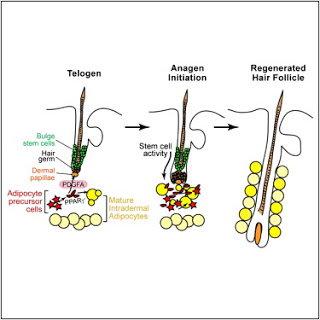The researchers identified stem cells within the skin’s fatty layer and showed that molecular signals from these cells were necessary to spur hair growth in mice, according to research published in the Sept. 2 issue of the journal Cell.
“If we can get these fat cells in the skin to talk to the dormant stem cells at the base of hair follicles, we might be able to get hair to grow again,” said Valerie Horsley, assistant professor of molecular, cellular and developmental biology and senior author of the paper.
Journal Cell – Adipocyte Lineage Cells Contribute to the Skin Stem Cell Niche to Drive Hair Cycling
Men with male pattern baldness still have stem cells in follicle roots but these stem cells lose the ability to jump-start hair regeneration. Scientists have known that these follicle stem cells need signals from within the skin to grow hair, but the source of those signals has been unclear.
Horsley’s team observed that when hair dies, the layer of fat in the scalp that comprises most of the skin’s thickness shrinks. When hair growth begins, the fat layer expands in a process called adipogenesis. Researchers found that a type of stem cell involved in creation of new fat cells — adipose precursor cells — was required for hair regeneration in mice. They also found these cells produce molecules called PDGF (platelet derived growth factors), which are necessary to produce hair growth.
Horsley’s lab is trying to identify other signals produced by adipose precursor stem cells that may play a role in regulating hair growth. She also wants to know whether these same signals are required for human hair growth.
Highlights
* Resident skin adipocytes regenerate de novo in parallel with the hair cycle
* Immature adipocytes are necessary and sufficient for hair follicle regeneration
* Immature adipocytes express PDGF ligands to promote hair regeneration
Summary
In mammalian skin, multiple types of resident cells are required to create a functional tissue and support tissue homeostasis and regeneration. The cells that compose the epithelial stem cell niche for skin homeostasis and regeneration are not well defined. Here, we identify adipose precursor cells within the skin and demonstrate that their dynamic regeneration parallels the activation of skin stem cells. Functional analysis of adipocyte lineage cells in mice with defects in adipogenesis and in transplantation experiments revealed that intradermal adipocyte lineage cells are necessary and sufficient to drive follicular stem cell activation. Furthermore, we implicate PDGF expression by immature adipocyte cells in the regulation of follicular stem cell activity. These data highlight adipogenic cells as skin niche cells that positively regulate skin stem cell activity, and suggest that adipocyte lineage cells may alter epithelial stem cell function clinically.
If you liked this article, please give it a quick review on ycombinator or StumbleUpon. Thanks

Brian Wang is a Futurist Thought Leader and a popular Science blogger with 1 million readers per month. His blog Nextbigfuture.com is ranked #1 Science News Blog. It covers many disruptive technology and trends including Space, Robotics, Artificial Intelligence, Medicine, Anti-aging Biotechnology, and Nanotechnology.
Known for identifying cutting edge technologies, he is currently a Co-Founder of a startup and fundraiser for high potential early-stage companies. He is the Head of Research for Allocations for deep technology investments and an Angel Investor at Space Angels.
A frequent speaker at corporations, he has been a TEDx speaker, a Singularity University speaker and guest at numerous interviews for radio and podcasts. He is open to public speaking and advising engagements.


